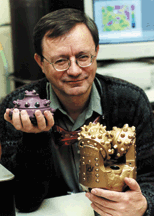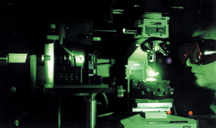Learning rubber
TCU physicist
Waldek Zerda is helping tire manufacturers reinvent the wheel
By Nancy Bartosek

 It's
been called the largest vehicular product crisis in this country's history
and one of the most puzzling safety issues in decades. Since the early
1990s more than 100 deaths and many serious injuries were linked to Ford
Explorers when certain Firestone tires blew their treads. In December,
an internal Firestone investigation revealed that while Ford vehicle design
and customer tire abuse were factors in the deaths and injuries, faulty
tires did play a part in these tragic accidents. More than 6.5 million
tires manufactured by Bridgestone/Firestone Inc. have been recalled. It's
been called the largest vehicular product crisis in this country's history
and one of the most puzzling safety issues in decades. Since the early
1990s more than 100 deaths and many serious injuries were linked to Ford
Explorers when certain Firestone tires blew their treads. In December,
an internal Firestone investigation revealed that while Ford vehicle design
and customer tire abuse were factors in the deaths and injuries, faulty
tires did play a part in these tragic accidents. More than 6.5 million
tires manufactured by Bridgestone/Firestone Inc. have been recalled.
In a small office in the bowels of the
Sid W. Richardson building, physicist Waldek Zerda shakes his head and
pauses when asked if he knows what went wrong with the Firestone tires.
"I think we know what the problem is, butÉ,"
the soft-spoken researcher said, a smile crossing his normally serious
visage. "No, I don't want to make a statement. What they will do, I don't
know. But I think our work will help them understand polymers in tires
and polymer reinforcing mechanism." A quintessential researcher -- quiet,
introspective and deeply fascinated by minutia -- Zerda takes a very close
look at what makes a tire a tire.
The lean Polish native stepped from behind
his desk, in one hand a pale-yellow glob -- rubber -- and in the other a small
vial of black powder -- Zerda's expertise.
"I will show you this but not invite you
to touch it," he advised as he shook the vial. Called "carbon black,"
it is produced from oil and is the same substance that clings to the walls
of your fireplace. Simply put, soot.
 |
| In
the limelight. Patience is not only a virtue to a physicist, itŐs
a necessity; setting up the path of the green laser used in ZerdaŐs
unique microimaging process takes two full days. Another of his current
projects is developing diamond-hard tips for RockBit International
oil-well drills, such as the one he is holding in the photo on the
opposite page. |
About 50 percent of the tire your car rolls
on is made from it. The tire manufacturers get different grades of carbon
black and mix it with polymers (various rubbery substances) to create
a product with specific properties.
Different parts of the tire need composites
of various properties -- the tread must be stiff and hard, the sidewalls
soft and pliable.Tire makers like Firestone bond these polymers together.
Chemistry is not at work here, but rather pure physics. Pressure, heat
and time. Problems arise when the various parts -- usually the tread to the
body of the tire -- don't adhere properly.
Zerda and his graduate students, along
with scientists from the Sid Richardson Carbon Co. and ExxonMobil (which
both fund Zerda's research), have found a way to look at the molecular
structure of these composites.
This unique mapping process identifies
the distribution of the composites down at the molecular level to understand
the way they behave under different circumstances. The information will
allow tire engineers to see precisely how the various polymers are distributed
in the tire, thus helping them to develop better ways to build a tire.
"The goal is to help them manipulate and
control the process," Zerda said. "With this information, they can change
manufacturing processes and make a new grade, better. That's a very important
issue."
Though Zerda's method of looking at everyday
products at the molecular level may affect where the rubber hits the nation's
roads, it travels well beyond the steel-belted radial. His understanding
of polymers naturally fits with work he is doing with other forms of carbon
black. Diamonds, graphite, coal and coke used in steel manufacturing are
all based on the element carbon.
Marvin Gearhart, CEO of RockBit International,
wants a stronger oil drill bit so Zerda is using inexpensive, man-made
diamond crystals to create a diamond-hard tip for the bits. Texas Instruments
is looking for a better way to protect their silicon chips.
Zerda works to devise a way to place a
microscopically thin diamond film over the top of the chips. And Chevron
Corp. needs to eliminate carbon buildup in engines. Zerda is investigating
the microstructure of the deposits so they can find additives that will
better breakdown the buildup.
"I never wanted to do research for the
sake of research," Zerda said. "I wanted to find possible connections
with commercial applications. "Knowing I'm doing something that will help
improve the world is a nice thing."

This contour
map depicts the distribution of two polymers, Exxpro and BR, the latter
a typical polymer in tires. Blue indicates high concentration of Exxpro,
red areas enriched in BR. This sample -- less than the width of a human hair -- demonstrates
poor mixing. Ideally, the two polymers should be mixed evenly with no
increased concentration of any of the ingredients at any given spot. How
does Zerda create the image? A laser directed at the sample reflects many
different colors, with different polymers producing different colors.
Top
|



